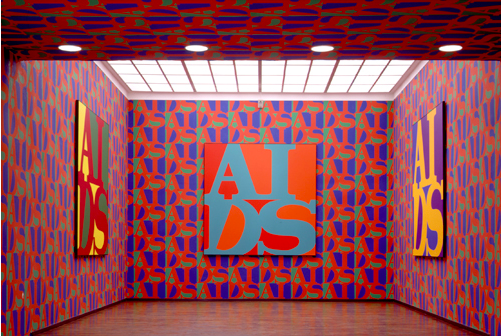Long ago, I announced my desire to see This Will Have Been: Art, Love & Politics in the 1980s, an exhibition that began at the MCA Chicago and was coming to the ICA Boston, put together by a curator whose work I greatly admire, Helen Molesworth. I mentioned it in the context of my interest in a Canadian trio known as General Idea, whose Robert Indiana-inspried AIDS wallpaper was included in the show, as well as in a theoretical exhibition I’d designed in graduate school. As I explained, the banner image used in exhibition publicity was not dissimilar from my own installation.
Theirs:

Installation by General Idea in “This Will Have Been: Art, Love & Politics in the 1980s” at the MCA Chicago
Mine:

My theoretical exhibition, as designed in Google SketchUp, , which you can view in more detail and navigate in 3D here
I believe the publicity image above must have been of the exhibition in its Chicago iteration; in Boston, where I finally saw the show on its last day, General Idea was given less prominence. One side of a freestanding wall had the wallpaper on it, but it was covered with works by other artists, not by General Idea.
Despite this slight misleading, I thoroughly enjoyed the exhibition, as art of the 1980s has been one of my primary interests. The exhibition was a great combination of very famous and expected artists and artworks, and since forgotten (at least by most) names, treating similar themes.
One work that made both literal and figurative great impact in person as opposed to in an anthology of ’80s art was David Hammons’ How Ya Like Me Now?, a wall-sized, whitened and blondified portrait of Jesse Jackson with those words graffitied across his shoulder. Something I hadn’t known about the work was that when it was first exhibited outdoors, black teenagers attacked it with sledgehammers, reading it as racist, rather than as opposed to racism–a telling dynamic in and of itself. Brilliant artist that he is, Hammons has highlighted this ever since, exhibiting the piece surrounded by a fence-like arrangement of sledgehammers, the evidence of their damage on the piece still visible.
Beyond that particular highlight, I’m not sure I have much else to say about the show, as it was enjoyable but not surprising to someone well-versed in the era. Walking through it was like going down a checklist–“there’s one of those, there’s one of those…” It was well-organized by theme, well-selected, and I’m glad I saw it. One of the interesting issues about such art is how didactic and contextual it is. Without foreknowledge of the work, reading the label is usually necessary–the texts were at times overly long, and occasionally the interpretations a bit overblown.
Such is the legacy of the art of that era, at the height of postmodern theory. It’s extremely fascinating to me, but I often have trouble explaining why that is to even those within my field, much less those without.
